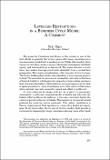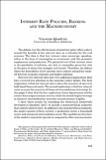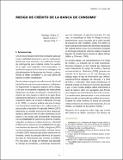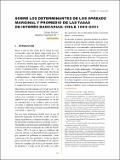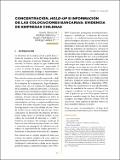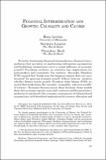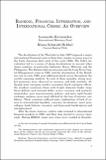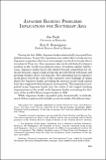Buscar
Mostrando ítems 21-30 de 31
Leverage restrictions in a business cycle model
We seek to develop a business cycle model with a financial sector which can be used to study the consequences of policies to restrict the leverage of financial institutions (banks). Because we wish the model to be consistent with basic features of business cycle data we introduce our banking system ...
Leverage restrictions in a business cycle model: a comment
The paper by Christiano and Ikeda in this volume is one of the first efforts to quantify the welfare gains of leverage constraints in a macroeconomic model with a banking sector. Unlike other models their answer is that they can be even more desirable when banks hold little equity and intermediation ...
Interest rate policies banking and the macroeconomy
The debate over the effectiveness of monetary policy often centers around the benefits of low interest rates as a stimulus for the real economy. The idea is that low interest rates encourage spending either in the form of consumption or investment and this promotes employment and production. The ...
Credit stabilization through public banks: the case of Banco Estado
A novel element in the policy mix that responded to the 2008- 2009 financial crisis was the explicit role given to BancoEstado a publicly-owned commercial bank to alleviate the contraction in domestic credit provided by the banking sector. In order to aid its mission BancoEstado was capitalized by 500 ...
Riesgo de crédito de la banca de consumo
Siguiendo a Jara y Oda (2007), consideramos un grupo de bancos Chilenos especializados en créditos de consumo. Tomando la dinámica del grupo agregado, proponemos un modelo de riesgo de crédito basado en el gasto en provisiones. Utilizando relaciones contables, mostramos que el modelo es dinámico y ...
Sobre los determinantes de los spreads marginal y promedio de las tasas de interés bancarias: Chile 1994-2001
El estudio de los spreads de tasas de interés bancarias es clave para entender el proceso de intermediación financiera. Por lo general, la disponibilidad de datos restringe los análisis empíricos a medidas de spreads construidas a partir de los estados financieros de los bancos. Nuestro estudio ocupa ...
Concentración, hold-up e información de las colocaciones bancarias: evidencia de empresas Chilenas
El artículo contiene un estudio empírico de la relación banco-cliente, basado en una muestra de empresas manufactureras Chilenas. En él se analiza si la concentración y la duración de la relación entre deudor y acreedor afectan el volumen de endeudamiento bancario. Los resultados indican que la menor ...
Financial intermediation and growth: causality and causes
Do better functioning financial intermediaries -financial intermediaries that are better at ameliorating information asymmetrics and facilitating transactions- exert a causal influence on economic growth? Providing evidence on causality has implications for policymakers and economists. For instance, ...
Banking, financial integration, and international crises: an overview
The devaluation of the Thau bath in July 1997 triggered a major international financial crisis in East Asia, similar in many ways to the Latin American debt crisis of the early 1980s. The baht´s devaluation led to a Seriesos sharp devaluations in several other Asian countries, in particular Indonesia, ...
Japanese banking problems: implications for Southeast Asia
During the late 1980s, Japanese banks substantially increased their global presence. In part the expansion was undertaken to help service Japanese companies that were increasingly involved in foreign direct investment. However, this expansion also can be attibuted to Japan's positio as the world's ...


